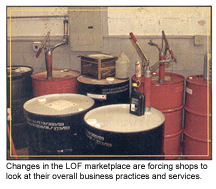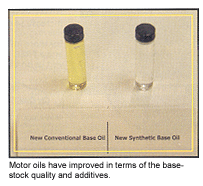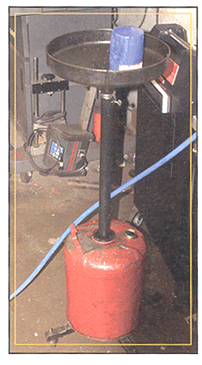The lube business is changing. The vehicles, intervals and customers are changing. These changes are forcing shops and quick lubes to look at their overall business practices and services.
It is difficult for any shop to survive without offering the traditional Lube, Oil and Filter (LOF). According to one shop’s data, the LOF is the one service that spawns the most additional sales. But, many shops have difficulties in harnessing this simple service to feed their other bays, while still remaining profitable on the lowly LOF itself.
 Changing Vehicles
Changing Vehicles
To understand where the LOF market is going, look at late-model vehicles. Their engines have improved in terms of oil blow-by and oil consumption. These improvements are apparent when you consider that most 2005 passenger vehicles and light trucks do not have a Positive Crankcase Ventilation (PCV) valve.
Motor oils have also improved in terms of the base-stock quality and additive package. Motor oil contains detergent additives that neutralize blow-by contaminants and help keep the inside of the engine clean. Oxidation inhibitors in the oil also help it withstand high temperatures that would cause it to break down. Improvements in these additives have enabled automakers to extend oil change intervals to unheard of mileages, while not causing significant damage to an engine. One oil supplier is now marketing a 15,000-mile oil that can deliver on this promise for newer vehicles.
Newer vehicles can now tell the driver when to change the oil. It is common to see a “CHANGE OIL SOON” light on most new vehicles.
The vehicle is not testing the oil with a sensor. Instead, it is using a computer program that estimates when the oil should be changed. The computer makes the decision to turn on the light according to the habits of the driver and the properties of the recommended motor oil.
The trouble with this approach is that the programming may not take into account the effects of engine wear on blow-by or unusual operating conditions, such as driving on dusty roads. Also, it is unknown how much of a “fudge factor” is built into the programming to account for people who ignore the oil change light.
 The change oil light is making some consumers leery of getting their oil changed at any place other than the dealer. Consumers fear that an aftermarket shop can’t turn off the light. But, turning off this light usually requires nothing more than pressing a variety of buttons in the cockpit in a sequence. The procedure is usually outlined in the owner’s manual.
The change oil light is making some consumers leery of getting their oil changed at any place other than the dealer. Consumers fear that an aftermarket shop can’t turn off the light. But, turning off this light usually requires nothing more than pressing a variety of buttons in the cockpit in a sequence. The procedure is usually outlined in the owner’s manual.
This is not the death of the 3,000 mile/3-month oil change. With the average age of a vehicle around nine years, the majority of the vehicle population is not equipped with oil change lights and/or engines that are designed to withstand extended intervals. Also, the light may not deter the oil change fanatics who believe in the 3,000-mile/3-month practice. But, it is also important to tell customers that regular oil changes can be the best way to protect their investment.
New technology means a shift in the market in the future. Either your shop can take advantage of this trend, or ignore it.
Vehicle Leasing Trends
In the 1990s, it was often said that the increasing rate of vehicle leasing was bad for the LOF market. It was not unheard of for a driver to not change the oil during a two-year lease. But, over the past three years new trends in vehicle leasing are reversing this behavior.
According to National Automotive Dealers Association, the rate of vehicle leasing is going down. Also, the average length of a lease is increasing. Some automakers are even offering four- and five-year leases. This means that the driver cannot neglect regular maintenance if they expect the vehicle to last the length of the lease.
Changing the Psychology of the LOF
Today, it is about the low priced oil change. You can see ridiculously low prices advertised in newspapers and on vinyl banners by the side of the road. Some shops even advertise the price to change just the oil and not the filter in order to be the lowest price in town. But, this cost marketplace is losing its luster with some consumers.
Most consumers believe in the saying “if it sounds to good to be true, it is generally not true.” Most consumers assume that the cheap oil change is the bait to get them into the shop for additional services that they do not need. Like driving into a bad neighborhood, they lock their mind like a car door to additional services when they enter some lube bays and shops.
Shops have taken the attitude that an LOF is a “loss leader” that is designed to be bait to get customers to fill the bays. It is still a common practice to send out oil change coupons in the mail, or put a coupon in the newspaper. For some shops, it can attract the wrong kind of customer.
Some techs avoid “LOF only/with coupon” repair orders like the plague. They figure that they are better off waiting for the next repair order that may be more profitable, like a dangling muffler or grinding brakes.
When these attitudes clash, it is very counterproductive for the customer and shop. The customer is not open to additional services and technicians are less likely to perform a complete inspection. Changing this dynamic does not take a genius, it just takes common sense.
Understanding the customer’s frame of mind is one of the most important parts of being in business. Every item a consumer buys fulfills a need. The need may be self indulgent or practical, but fulfills a need of the consumer at a certain level. This decision is typically made before the consumer considers the price. But, some consumers are driven by price only. Getting the cheapest oil change with a coupon fulfills a sick emotional need. This is a customer that you do not want.
 People like to buy what is considered to be the best in the marketplace. It makes them feel good about their choice. This line of logical falls under the “needs” category and is part of a value proposition you can offer. This line of thinking and selling falls right in line with the changing vehicles and customers.
People like to buy what is considered to be the best in the marketplace. It makes them feel good about their choice. This line of logical falls under the “needs” category and is part of a value proposition you can offer. This line of thinking and selling falls right in line with the changing vehicles and customers.
Consider the needs of late-model vehicle owners in terms of an oil change. Their basic needs are to take care of their investment and turn off the “CHANGE OIL SOON” light. Price does not play a role at this time. This is your chance to sell the consumer the best oil change that fulfills their needs at all levels. Chances are that the customer has exceeded 5,000 miles or more on their oil. It is your job to present them a value proposition that goes beyond the value of a cheap oil change.
Selling to these “needs” gives you the opportunity to sell a more expensive LOF that can mean more profit for you. The consumer may be more receptive to buying semi- or fully-synthetic oils, better filters and other services. Also, if the technician makes a percentage on parts, it may make them more receptive to performing a better LOF and inspection.
